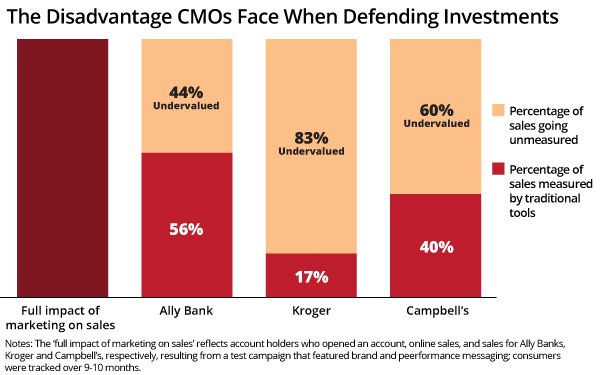
The Brand as Performance (BaP) framework
finally gives marketers a tool to "stop defending their budgets — and start demonstrating their real-world impact," according to a white paper released Thursday by TransUnion.
The
whitepaper, Brand as Performance: Giving Marketing the Credit it Deserves, examines case studies supported by the MMA Global's framework to examine how marketers can connect brand-building
efforts to measurable business outcomes that increase performance.
One challenge marketers face is that many of the tools used to measure marketing's contributions to companies are focused
on short-term performance, and they often dramatically underestimate the full impact of brand on sales -- sometimes by as much as 83%.
Since this perception gap has real consequences,
TransUnion developed the whitepaper in partnership with MMA Global. It features recent case studies from Ally Bank, Kroger, and Campbell’s. Each demonstrates how to quantify long-term
growth in brand marketing through a BaP framework that was developed in 2022.
advertisement
advertisement
The whitepaper suggests that boardrooms once favored short-term performance, until BaP changed that perception by
proving how brand-building translates directly to customer acquisition, retention and sales.
At the core of the BaP method sits one truth, according to the whitepaper. That truth is that brand
marketing increases favorability — and growing favorability grows business because consumers favor the brand. TransUnion called this "the favorability pathway."
The data and examples
show how marketing’s impact on business has been undervalued by up to 83% under previous methods. Marketing also drives favorability with lifts of up to 24%, even for established brands,
according to the data.
Favorability drives conversion, meaning that the more positive consumers feel about a brand, product, or service, the more likely they are to purchase its products. The
data showed that favorable consumers purchase 4 to 5x more than non-favorable consumers.
Kroger used brand messaging to increase favorability by 24%, with long-term online sales impact 6x
higher than short-term.
Overall, the long-term effects are 1.8x to 6x greater than short-term effects.
A brand-first strategy can deliver real business growth, according to the data,
as demonstrated by Ally Bank. Its brand-first strategy drove 16% more new customers and 29% more accounts compared to short-term tactics, according to the whitepaper.
To achieve the best
possible returns or outcomes from marketing and business investments, a significant portion of resources should be allocated toward building and strengthening the brand -- for example, 90% brand
messaging anchored by 70% brand connected television (CTV), per the data.
Even with a household name like Campbell’s, brand favorability proved critical — favorable consumers
purchased at 2.9x the rate of non-favorable.
The data in the whitepaper suggests these causality-based approaches supported by BaP connects marketing activities to outcomes like consumer
sentiment, as well as sales at the household level on a broad scale and over time.
Unlike traditional approaches, this builds a direct bridge between brand and behavior for the first time.